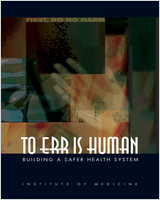 by James C. Sherlock
by James C. Sherlock
In my career in private industry, I worked for a time with the testing and implementation of a hospital operational management system. My work there was shaped in considerable part by the 2000 report of the National Academy of Sciences, To Err is Human: Building a Safer Health System.
I came across a report today that I think it important to share. You would not normally see it if you are not in the health care business. It concerns patient safety. It is a Joint Commission report on sentinel event data.
This is not the kind of thing we normally write about here, but patients certainly experience sentinel events in Virginia, and I think it important enough to break that tradition.
The Joint Commission is by far the largest body evaluating health care organizations. A sentinel event is
“a patient safety event (not primarily related to the natural course of the patient’s illness or underlying condition) that results in any of the following:
- Death
- Permanent harm
- Severe temporary harm and intervention required to sustain life”
Most sentinel events are issues of which patients and loved ones should not only be aware, but should check with the provider on in-place prevention measures. Most of the sentinel events themselves are self-reported by the facilities.
The best ones will appreciate your interest in their prevention.
The most common sentinel events by far are falls, and most of those (85%+) happen in hospitals. The rest of the sentinel-event falls occur in behavioral health, ambulatory health, home care, critical access hospitals and nursing homes in descending order.
After falls, the most frequent sentinel events are:
- Unintended Retention of a Foreign Object from surgery,
- Wrong surgery (wrong patient, wrong site, wrong procedure, wrong implant),
- Suicide; and
- Delay in treatment.
I will focus here on falls. They can be minimized by your knowledge of the hazards and protective measures. The most common contributing factors are:
- “Inadequate assessment of the patient.” If you are a loved one accompanying a patient who cannot care for himself, you should inquire about the assessment and see if it roughly matches what you have observed. If not, say something.
- “Communication failures within the facility.” This can happen when transferred between services in a hospital or at shift change. It is worth knowing when shift changes happen and, especially on weekends and holidays, inquiring of the first nurse who visits after a shift change what she understands to be the patient’s diagnosis and fall hazards;
- “Lack of adherence to protocols and safety practice.” It is worth asking what those protocols are. If you notice those protocols not being observed, speak up.
- “Inadequate staff orientation, supervision, staffing levels or skill mix.” Nursing shortages are severe, and about 10% of nurses in hospitals nationwide today are travel nurses on 4-week or three-month contracts. See #2 above. Don’t hesitate to ask those two questions.
- Deficiencies in the physical environment. These should be caught and fixed by the facility, but look for things like cords where they should not be, wet floors, etc.
- Lack of leadership. Again, see #2.
Perhaps the most devastating fall hazards are newborn falls and drops. Facilities have been notified of this hazard and will be active in their prevention, but so should you.
The Joint Commission in 2018 called for increased attention
“to the underrecognized issue of infant falls and include most prevalent maternal risk factors associated with newborn falls and drops as:
- Cesarean birth;
- Use of pain medication within four hours;
- Second or third postpartum night, specifically around midnight to early morning hours; and
- Drowsiness associated with breastfeeding”
They warned that the important goal of early skin-to-skin contact, frequent maternal infant interactions, and the promotion of breastfeeding can lead to increased risk of a newborn fall or drop.
“Those at highest risk should be counseled on the risks for newborn falls and drops and the need to call for help when feeling tired or sleepy. All parents should be cautioned against falling asleep with their newborn in the bed or co-sleeping with their newborn.”
The hospital should have a process in place to warn the new mother of these hazards and help her avoid them, but put this on your go-to-the-hospital or home-birth checklist.
Finally, health care facilities are run and staffed by professionals. But to err is indeed human.
As I wrote earlier, the best professionals will appreciate your interest in sentinel event prevention.


